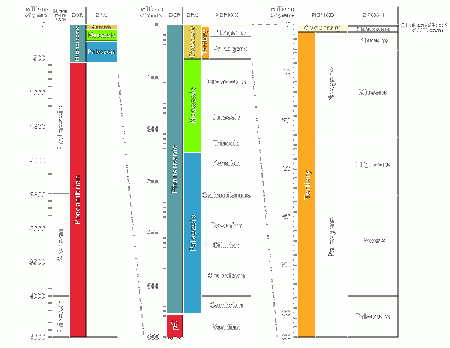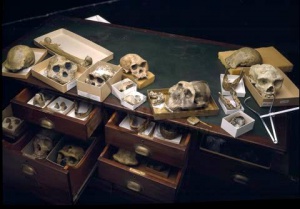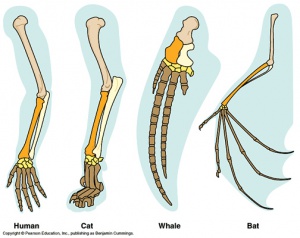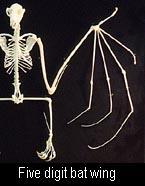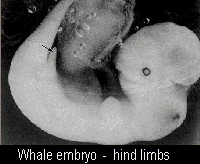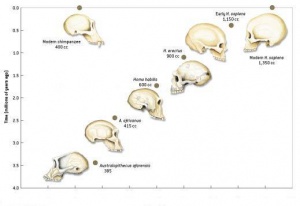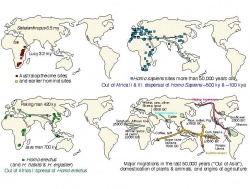The fact of evolution
"Well evolution is a theory. It is also a fact. And facts and theories are different things, not rungs in a hierarchy of increasing certainty. Facts are the world's data. Theories are structures of ideas that explain and interpret facts. Facts don't go away when scientists debate rival theories to explain them. Einstein's theory of gravitation replaced Newton's in this century, but apples didn't suspend themselves in midair, pending the outcome. And humans evolved from ape-like ancestors whether they did so by Darwin's proposed mechanism or by some other yet to be discovered.
Moreover, "fact" doesn't mean "absolute certainty"; there is no such animal in an exciting and complex world. The final proofs of logic and mathematics flow deductively from stated premises and achieve certainty only because they are not about the empirical world. Evolutionists make no claim for perpetual truth, though creationists often do (and then attack us falsely for a style of argument that they themselves favor). In science "fact" can only mean "confirmed to such a degree that it would be perverse to withhold provisional consent." I suppose that apples might start to rise tomorrow, but the possibility does not merit equal time in physics classrooms.
Evolutionists have been very clear about this distinction of fact and theory from the very beginning, if only because we have always acknowledged how far we are from completely understanding the mechanisms (theory) by which evolution (fact) occurred. Darwin continually emphasized the difference between his two great and separate accomplishments: establishing the fact of evolution, and proposing a theory--natural selection--to explain the mechanism of evolution."
- - Stephen J. Gould [Harvard University]
Contents |
Quick evolution primer
Time
First, having a realistic perception of time is a must. If you put the entire age of the earth into one hour, that is "4.6 billion years", the first 50 minutes would be mostly made up of single celled organisms and the last ten minutes made up of animal life--humans having only been on this planet for about two seconds.
Geological time scale
Layers of earth are arranged in a time sequence, with the oldest on the bottom and the youngest on the top, unless later processes disturb this arrangement. The age of the layers can be determined using radiometric dating methods and confirmed by other scientists worldwide thereby providing estimates of the age of organisms contained in each layer.
All across our planet we get sequences of fossils found in certain layers of strata. The types of fossils that are found in these layers are rarely mixed and consist of less complex organisms in lower, older layers and the more complex organisms in the higher, younger layers. Through this method of analysis, scientists have illustrated life evolving from less complex to more complex organisms.
Transitional fossils
Scientists have found many transitional fossils that have all been chronologically dated that clearly show within millions of years one species evolving into another. Many organisms do not fossilize due to carbon decay and potential discoveries may be lost as a result; however, despite this, there are numerous examples of transitional fossils. In fact, there are so many reptilian/mammal fossils that paleontologists often argue about what to call them, reptile-like mammals or mammal-like reptiles. Yet, all are in agreement, it is clear that evolutionary transitions are occurring over the course of millions of years. Other transitional fossils include whales, horses, birds, hominids, etc.
Vestigial structures
Vestigial structures are structures of an organism that have lost all or almost all of their original function through evolution. Examples include the wings of ostriches, emus, and other flightless birds, which are remnants of their flying ancestors' wings. Also, the eyes of certain cavefish and salamanders are vestigial, as they no longer allow the organism to see,and are remnants of their ancestors' functional eyes.
Homologies
A homology is a character shared between species that was also present in its common ancestor. Examples include all tetrapods (four legged creatures), which have a basic pentadactyl limb structure (or five fingers and toes on each hand and foot). The forelimbs of a bat, whale, human and cat are all constructed from the same bones and are morphologically very similar, despite performing different functions.
Embryonic similarities
Sometimes in ontogeny (embryonic development) certain features are observable in an organism but in later embryonic stages they disappear. Such occurrences can help scientists trace an organism's past thereby helping to place organisms on a more probable phyletic line (tree of life). Examples include whales and dolphins which have evolved from land mammals, which do not have legs, but instead possess tiny, remnant leg bones that lie buried deep in their bodies. During embryonic development, leg extremities first occur, then recede. Similarly, whale embryos (like all mammalian embryos) have hair at one stage, but lose most of it later.
Primatology and animal behavior
In birds and mammals the nervous system grew yet more complex, developing a cortex around it. With the cortex came other new abilities. A dog chasing a cat around a corner holds some image in its mind of the cat it can no longer see. Creatures with a cortex have memory and recognition; they can pay attention and show intention.
With primates the cortex grew into the larger, more complex neo-cortex, adding yet more features to consciousness. The most significant of these was the ability to use symbols. Not only did this ability enable simple reasoning, it also led to a new form of communication symbolic language.
Chimpanzees and gorillas may not be able to speak as we do, but this is not because they lack something in their brains; they lack a voice. They have no larynx, or voice-box, and cannot move their tongues as freely as we can. But they can use other forms of symbolic language. When taught sign language, such as that used by the deaf, they show a remarkable ability to communicate. Coco, a gorilla in California, now has a vocabulary of more than a thousand words, and composes sentences in sign language.
The Process of Evolution
Gene flow
Gene flow is the introduction of genetic material (through reproduction) from one population of a species to another, thereby changing the composition of the gene pool of the population. The introduction of new characteristics through gene flow increases the variability of genetic material within the population and makes possible new combinations of traits. Gene flow usually comes about through migration.
Mutation
According to their evolutionary significance, three kinds of mutations can be distinguished:
- beneficial
- neutral
- deleterious
Ken Miller on Genetic evidence of evolution:
Individuals with genotypes that contain a beneficial mutation will be favored by natural selection since the organism will survive long enough to reproduce and pass its genetic material to its offspring. However, since almost all conceivable beneficial mutations of a population in a stable environment have already been selected in the recent past, the occurrence of new beneficial mutations is rather rare. Mutations that do not affect the fitness of the phenotype, so-called neutral mutations, are frequent.. Finally, deleterious mutations will be selected against and will be eliminated in due time since the mutation may be detrimental to the survival of the organism. And, if the organism is not capable of surviving long enough to reproduce and pass its genetic material to its offspring, then the likelihood is that this mutation may not be distributed throughout the population.
Genetic drift
Genetic drift is the change in the pool of genes of a small population that takes place strictly by chance. Genetic drift can result in genetic traits being lost from a population or becoming widespread in a population without respect to the survival or reproductive value of the gene pairs (alleles) involved. A random statistical effect, genetic drift can occur only in small, isolated populations in which the gene pool is small enough that chance events can change its genetic makeup substantially. In larger populations, any specific allele is carried by so many individuals that it is almost certain to be transmitted by some of them unless it is biologically unfavorable.
Natural selection
Natural selection is the process by which favorable traits that are inheritable become more common in successive generations of a population of reproducing organisms, and unfavorable traits that are inheritable become less common. An understanding of the nature of populations is of the utmost importance for an understanding of evolution, because all evolution, and particularly selection, takes place within populations. The concept of natural selection is based on observations of the natural world. Almost every species produces vastly more offspring than can survive from generation to generation. All the individuals of a population slightly differ genetically from each other (variation) and as they are exposed to the adversity of the environment, some of these organisms may perish and fail to reproduce. On the other hand, some will survive and reproduce. These survivors are not a random sample of the population; their survival was aided by the possession of certain attributes that favored survival. As a result, the traits that allowed the parents to survive and pass down to their offspring will likely be contained in the population and continuously passed down to new generations of offspring.
Keep in mind that natural selection is only one process of evolution and should not be used to replace the term, "Evolution".
Instead, evolution consists of multiple processes as described above, which include natural selection, gene flow, genetic drift, and mutations.
The two steps of Evolution
Thus, evolution can be viewed as a two step process:
- The origin of genetic variation by mutation or recombination;
- followed by changes in the frequencies of alleles (variants of a gene) and genotypes, caused chiefly by genetic drift or natural selection.
The Chronology
Many species have been analyzed and observed to change into another within millions of years, dinosaurs to birds, land animals to whales, manatees, and other aquatic mammals. The same can be said for humans, what we need is to form a chronology of an animal transitioning to another, we need DNA sequencing to match predicted ancestry, we need many fields of science all correlating to point at one answer. And that is exactly what we have in regards to human evolution, not only would it be perverse to deny all the evidence but evolution via descent with modification is the only scientific model that exists.
Becoming human
The chronological sequence of hominid fossils we have unearthed clearly shows a transitioning from a quadrupedal (walking on four limbs) to a bipedal (walking on two limbs) creature. Also, the transition of the last approximately six million years has revealed a transformation from hominids that were adapted to climbing trees. The brain size in modern hominids compared to early hominids has doubled, the face has become much less protruding, our legs have grown longer, our arms shorter, our fingers less curved (since we don't live in trees anymore). Also, we humans have evolutionary baggage (vestiges) that we can see today, for example, we have wisdom teeth that most often do not fin in our mouths, why? Because early hominids had bigger jaws for chewing thick vegetation. To correlate with a strictly to mostly vegetarian diet, we have an appendix which is found in herbivore animals and helps digests vegetation, there is many more human vestiges the list goes on and on. Pretty much every portion of anatomy has and is being observed to have evolved from ape-like creatures who walked the savannas in Africa millions of years ago.
To match the sequence of transitional fossils over millions of years we have the geographic distributing of fossils spangled about in east and southern Africa for the early more ape-like hominids then slowly easing out of Africa and becoming more human-like. To add to the evidence we have an advancement in tool use to correlate with the fossils, we can see that innovation evolved too, less to more complex tools. Along with the fossils and tools we have genetics, in our DNA we have genetic markings, with that we can trace someone back to their original location or tribe, with genetic markings we have matched what evolution has predicted, mankind originating in Africa (The cradle of mankind).
Genetic evidence for Evolution
What else do we see today that is evidence for common ancestry? Genetic similarities increase when compared to animals that share a closer relationship with us, for example.
- Another human 100% - All humans have the same genes
- A chimpanzee 98% -Chimpanzees are the closest living species to humans.
- A mouse 92% - All mammals are quite similar genetically.
- A fruit fly 44%
- Yeast 26%
- Plant 18%
Not only do we share over a 98% DNA code with chimpanzees but we also share many homologous non-functional genes with chimps. Perhaps the Chromosome 2 fusion is the most striking, please watch Ken Miller explain, he does it a lot better than I could.
See Also
This site costs a lot of money in bandwidth and resources. We are glad to bring it to you free, but would you consider helping support our site by making a donation? Any amount would go a long way towards helping us continue to provide this useful service to the community.
Click on the Paypal button below to donate. Your support is most appreciated! |
|---|

